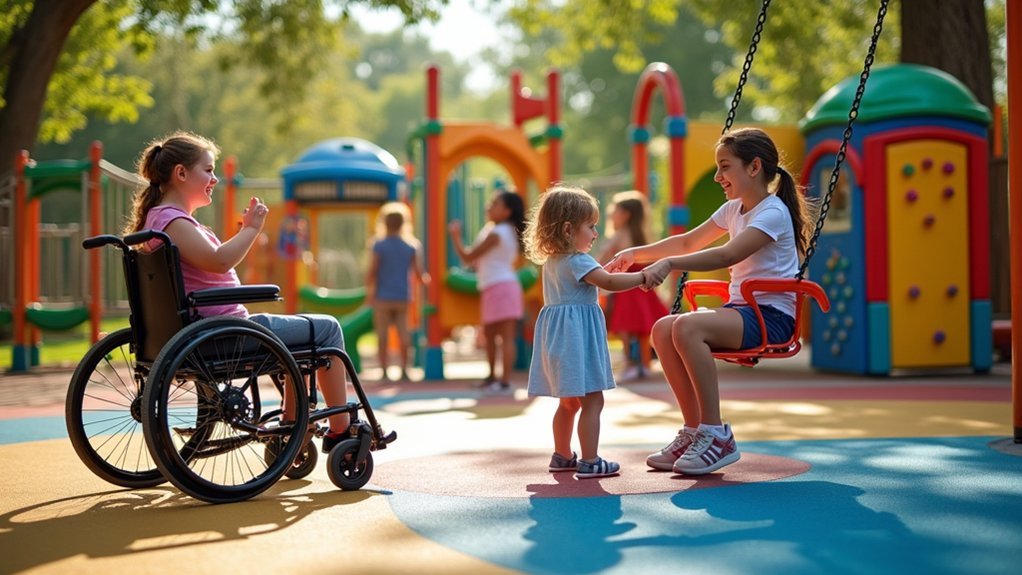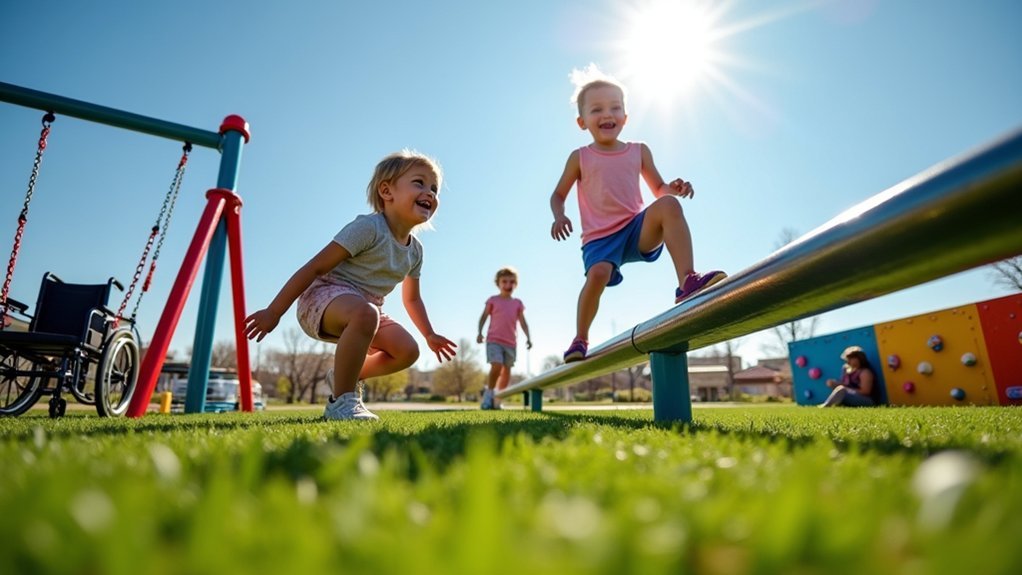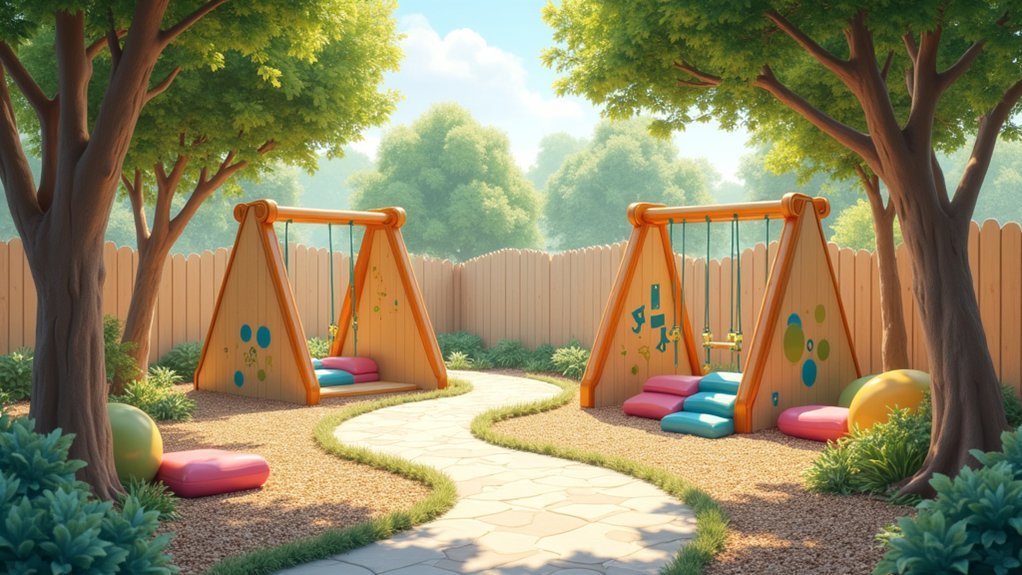Inclusive playground equipment serves children of all abilities with sensory-rich elements, accessible designs, and adaptive features. You’ll find wheelchair-accessible ramps, textured surfaces, quiet retreat areas, and collaborative play zones that engage multiple senses. Consider equipment with transfer systems, adaptive seating, and ground-level options that support both physical and cognitive development. Creating spaces where children connect regardless of ability fosters belonging and social growth—explore how these thoughtful design principles transform ordinary playgrounds into inclusive communities.
Creating Spaces Where All Children Belong: The Inclusive Playground Approach

While playgrounds have traditionally served as hubs for childhood recreation, many have unintentionally excluded children with disabilities through design barriers and limited accessibility options.
Today’s inclusive playgrounds challenge this paradigm by prioritizing the needs of children of all abilities.
Inclusive play spaces fundamentally reimagine recreation by placing accessibility and diverse abilities at the core of their design philosophy.
When you visit these thoughtfully designed spaces, you’ll notice accessible equipment like wheelchair-friendly ramps, sensory play elements, and specialized swings that enable meaningful play experiences for everyone.
Guided by universal design principles, these playgrounds foster valuable social interaction between children with varying abilities, enhancing their emotional development and sense of belonging.
What makes these spaces truly special is their foundation in community needs—incorporating input from families and experts to create environments where all children can connect, explore, and feel welcomed regardless of their physical or cognitive differences.
Sensory-Rich Equipment: Engaging Multiple Developmental Pathways
When you’re designing an inclusive playground, sensory integration opportunities become essential gateways for children of all abilities to connect with their environment.
Multi-sensory engagement zones featuring sound panels, textured surfaces, and interactive elements help children develop cognitive skills while fostering social interaction among peers with diverse abilities.
Texture-based play elements, strategically placed throughout the playground, provide valuable tactile experiences that stimulate brain development and can considerably reduce anxiety for children with sensory processing challenges.
Sensory Integration Opportunities
Because children experience their world through multiple senses, sensory-rich playground equipment serves as a crucial gateway to development for kids of all abilities. Sand tables and water play areas create perfect environments for sensory integration, allowing your child to explore different textures while strengthening cognitive development.
You’ll notice how interactive play panels and musical instruments engage children across multiple developmental pathways simultaneously. These elements stimulate touch, hearing, and movement, encouraging exploration that builds neural connections.
Bright colors and varied textures don’t just attract attention—they support fundamental sensory pathways that foster social interaction among diverse groups of children.
When kids interact with tactile panels and sensory paths, they’re developing fine motor skills while naturally connecting with peers, creating an inclusive environment where all children can thrive together.
Multi-Sensory Engagement Zones
Multi-sensory engagement zones create immersive play environments where every child can discover meaningful connections regardless of their developmental stage or ability level. These areas incorporate tactile panels, auditory devices, and visual stimuli that cater to diverse sensory preferences while stimulating cognitive development.
| Sensory Element | Developmental Benefit | Child Experience |
|---|---|---|
| Sand & Water Tables | Fine motor skills | “I can create and explore!” |
| Spinning Equipment | Vestibular awareness | “My body feels alive!” |
| Tactile Panels | Sensory processing | “I can feel differences!” |
| Quiet Zones | Self-regulation | “I can calm my body.” |
You’ll notice how these sensory-rich equipment options encourage children to engage multiple developmental pathways simultaneously. The thoughtful design of inclusive play areas promotes social interaction as children share experiences while respecting each other’s need for calming spaces when overwhelmed.
Texture-Based Play Elements
Three critical dimensions of texture-based play elements transform ordinary playgrounds into dynamic sensory landscapes for children of all abilities.
First, tactile panels and sensory walls provide diverse experiences that stimulate exploration through varied surfaces, supporting children with sensory processing disorders by creating calming, engaging environments that reduce anxiety and enhance focus.
Second, features like sand tables and water stations foster collaborative play experiences, encouraging communication and social interaction across developmental pathways.
You’ll notice children naturally gathering around these elements, developing bonds through shared tactile experiences.
Finally, texture-based elements are cornerstones of inclusive playground design, accommodating multiple learning styles while boosting cognitive development.
Research confirms these sensory-rich environments enhance problem-solving skills and imaginative play, allowing each child to engage with their surroundings according to their individual needs and preferences.
Accessible Design Features That Welcome Children With Physical Disabilities
When you’re designing inclusive playgrounds, wheelchair-accessible ramps and transfer systems create clear pathways for children with mobility devices to reach elevated play structures.
Sensory-rich ground surfaces offer both stability for wheelchairs and walkers while providing tactile stimulation that enhances play experiences for all children.
Adaptive seating options, including supportive swing seats and multi-user equipment, guarantee children with physical disabilities can participate comfortably alongside their peers rather than watching from the sidelines.
Ramps and Transfer Systems
Creating accessible play spaces requires thoughtful integration of ramps and transfer systems, which serve as the gateway to inclusive fun for children with physical disabilities.
These essential features transform ordinary play structures into truly inclusive playgrounds where all children can participate equally.
You’ll find that properly designed ramps feature gentle slopes and sturdy handrails, allowing wheelchair users to navigate independently to elevated platforms.
Transfer systems provide convenient platforms where children can shift from mobility devices onto equipment, encouraging self-sufficiency and dignity.
Remember that ADA compliance isn’t just about checking boxes—it’s about creating opportunities for meaningful social interaction.
When your playground incorporates these accessibility features, you’re not just providing physical access; you’re fostering friendships and shared experiences that benefit children of all abilities.
Sensory-Rich Ground Surfaces
Although often overlooked, sensory-rich ground surfaces form the foundation of truly inclusive playgrounds for children with physical disabilities.
You’ll find these accessible surfaces create opportunities for exploration while ensuring safety through slip-resistant rubberized materials that accommodate wheelchairs and walkers with ease.
Ground-level play elements integrated directly into these surfaces eliminate barriers, allowing children of all abilities to play side by side without separation.
Wide pathways and smooth connections between different textures help everyone navigate the playground independently.
- Varied textures stimulate tactile exploration and sensory development
- Bright colors provide visual stimulation for children with sensory processing needs
- Embedded sound features create multi-sensory play opportunities
- Rubberized materials offer cushioning for falls while remaining wheelchair-accessible
- Seamless connections prevent tripping hazards and allow smooth movement throughout the playground
Adaptive Seating Options
Despite their critical importance for inclusive play, adaptive seating options have only recently become a standard feature in playground design.
These specialized supports provide children with physical disabilities the security and comfort they need to fully engage in play experiences alongside their peers.
You’ll find various adaptive seating options in modern inclusive playgrounds, including seats with harnesses, backrests, and arm supports that guarantee stability during activities.
Most importantly, these features offer wheelchair accessibility, allowing children to shift smoothly from their mobility devices to play equipment without barriers.
Supporting Cognitive Development Through Adaptive Play Elements
When children engage with thoughtfully designed playground equipment, they’re not just having fun—they’re building essential cognitive skills.
Inclusive playground equipment that features adaptive play elements creates opportunities for children of all abilities to develop problem-solving strategies and creative thinking. You’ll find that these play environments encourage collaboration among diverse abilities, fostering vital communication skills and social interaction.
Inclusive play spaces empower every child to build cognitive skills while connecting across ability differences.
- Ground-level play options guarantee children with mobility challenges can access cognitive-stimulating activities
- Sensory panels and interactive musical instruments promote exploration and creativity
- Spinning and climbing elements improve spatial awareness and fine motor coordination
- Collaborative play structures enhance social skills important for cognitive growth
- Multi-sensory play experiences support emotional well-being, creating ideal conditions for learning
Movement and Balance Equipment for Diverse Mobility Levels

Inclusive playgrounds truly come to life through movement and balance equipment designed for all mobility levels. You’ll find wheelchair-accessible ramps and smooth surfaces that allow children with disabilities to play alongside peers, fostering valuable social interaction in accessible playgrounds.
| Equipment Type | Benefits | Accessibility Features |
|---|---|---|
| Revolution Spinner | Promotes group play | Wheelchair transfer options |
| Ground-level elements | Develops coordination | Accessible from all mobility levels |
| Upper body equipment | Builds strength | Usable from seated positions |
Play environments using inclusive design principles guarantee every child experiences physical engagement regardless of ability. Ground-level sensory paths and balance beams invite exploration for diverse mobility levels, while equipment featuring multiple interaction points accommodates different physical capabilities. When designing inclusive playgrounds, consider how movement and balance equipment creates opportunities for all children to develop essential motor skills together.
Social Interaction Zones: Fostering Connections Among Children of All Abilities
Thoughtfully designed social interaction zones serve as the heart of inclusive playgrounds, where children of all abilities can forge meaningful connections.
You’ll find these spaces equipped with collaborative features that encourage cooperative play while supporting diverse social preferences. Sensory-rich elements throughout these zones help children with processing challenges engage confidently with peers.
- Group swings and spinning platforms promote teamwork and shared experiences
- Accessible pathways allow children to navigate social spaces at their comfort level
- Collaborative equipment designs facilitate natural interaction between different abilities
- Multi-user stations encourage turn-taking and communication development
- Quiet corners adjacent to active areas provide social observation opportunities
Research confirms that these intentional play experiences greatly enhance social development, allowing children to build friendships while learning vital interpersonal skills through enjoyable, meaningful interactions.
Quiet Retreat Areas: Essential Spaces for Sensory Regulation

While active play zones buzz with energy and excitement, quiet retreat areas serve as essential sanctuaries within inclusive playgrounds.
These dedicated spaces allow children experiencing sensory overload to take necessary breaks and re-regulate their emotions before returning to play.
Sensory retreat spaces provide essential calm zones where overwhelmed children can reset before rejoining playground activities.
You’ll find these areas thoughtfully designed with calming features like comfortable seating, soft lighting, and natural sounds that create a soothing environment.
For children with sensory processing challenges, these elements provide critical support for emotional well-being and mental relaxation.
Multigenerational Design: Including Caregivers in the Play Experience
Beyond dedicated spaces for children’s varied needs, truly inclusive playgrounds must consider everyone who visits these spaces.
Multigenerational design recognizes that caregivers aren’t just supervisors but active participants in children’s play experiences. When you design with all abilities in mind, you’re creating environments where parents, grandparents, and caregivers of varying physical capabilities can engage meaningfully alongside their children.
- Wheelchair-accessible swings and gliders enable caregivers with mobility limitations to participate directly.
- Comfortable seating areas strategically placed throughout encourage supervision without isolation.
- Collaborative play elements foster social skills development through intergenerational interaction.
- Side-by-side equipment designs allow caregivers and children to play together regardless of ability.
- Inclusive play spaces strengthen emotional connections as families share experiences rather than merely observe.
Frequently Asked Questions
What Is the Typical Maintenance Schedule for Inclusive Playground Equipment?
You’ll need to inspect your inclusive playground equipment daily, perform weekly cleanings, conduct monthly detailed checks, and schedule professional inspections quarterly. Don’t forget seasonal maintenance before heavy use periods.
How Do Weather Conditions Affect Sensory-Rich Playground Materials?
Weather conditions greatly impact your sensory-rich playground materials. You’ll notice sun fades colors, extreme temperatures crack surfaces, moisture causes rust, and freezing cycles damage textures that were designed for tactile exploration.
What Funding Options Exist for Communities Building Inclusive Playgrounds?
You’ll find diverse funding through federal grants, community foundations, corporate sponsorships, crowdfunding campaigns, municipal bonds, and partnerships with disability organizations. Don’t overlook matching grants that can double your community’s fundraising efforts.
How Do Insurance Requirements Differ for Inclusive Playground Spaces?
You’ll need more extensive insurance for inclusive playgrounds due to specialized equipment and diverse user needs. Your policy should cover accessibility features and potentially higher liability limits than standard playground coverage.
What Training Should Staff Receive for Inclusive Playground Supervision?
You’ll need to train staff on disability awareness, communication techniques, accessibility features, behavioral support strategies, and emergency response protocols. Don’t forget to include empathy-building exercises and regular refresher courses for effective inclusive supervision.
In Summary
By embracing inclusive playground design, you’re creating more than just a play space—you’re building a community where every child belongs. Whether they’re exploring sensory panels, maneuvering wheelchair-accessible equipment, or finding calm in a quiet corner, children of all abilities thrive when you prioritize their diverse needs. Remember, the most successful playgrounds aren’t just fun—they’re places where differences are celebrated and no one sits on the sidelines.





Leave a Reply